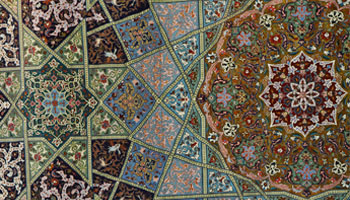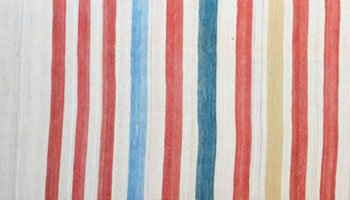Materials used in Persian Rugs and Oriental Rugs
 Superior rugs result when quality materials—silks and wools—are dyed with traditional, time-tested methods, handspun into yarn and tied by skilled artisans onto sturdy foundations, typically of cotton.
Superior rugs result when quality materials—silks and wools—are dyed with traditional, time-tested methods, handspun into yarn and tied by skilled artisans onto sturdy foundations, typically of cotton.
The Dominance of “Live Wool” in Hand-knotted Rugs
All of the best-quality handmade rugs are made from wool that is sheared from a live sheep, hence the term, “live wool.” Goat hair, also called cashmere, mohair or angora, and camel hair may also be used. (It’s interesting to note that goat hair is often used in its natural beige color and not dyed.) Wool shorn from animals living in cold climate regions is often more durable because it is more dense. Lamb’s wool is especially prized for its springy, yet fine texture.
In general, textile experts consider wool one of the softest and most durable natural fibers. It contains lanolin, a substance that makes it water-repellent. Wool is insulating, fire-resistant and highly sought-after for its soil resistance, flexibility and resilience. It is also beautiful, readily capturing and reflecting light. And because it absorbs dye so well, wool yarns can be produced in an astonishing array of colors, both brilliant and subtle: the deepest reds from pomegranates, yellows from saffron, blues from indigo and even the lightest and most delicate shades of pure ivory and white.
When knotted onto a solidly constructed foundation, wool wears like iron. Hand-knotted rugs of the best wool have an expected lifetime of 75 to 100 years and even longer. In fact, a high-quality wool rug improves over time. After many years of use, the wool may even resemble silk because the natural oils it contains rise to the surface of the fibers, polishing the yarn and resulting in a natural sheen.
The Use of Silk in Producing Oriental Carpets
A glossy long filament fiber, silk has been lauded for millennia for its smooth texture and brilliant colors. Silk rugs add luxury, elegance and distinction to any room. Most silk rugs today are produced in China and the Caspian region. An Oriental rug made from silk will be more delicate and generally more expensive than wool, and so are typically best suited for low-traffic areas of your home.
Cotton’s Common Appearance in Persian Rugs
A strong, natural fiber known and used for centuries, cotton is commonly used as the foundation for hand-knotted rugs. (While silk and wool may also be used, cotton is less susceptible to humidity and subsequent stretching.) Cotton strands are anchored onto specially-constructed looms to create the warp (lengthwise) and weft (horizontal) of the rug foundation. The rug-maker, sitting at the bottom of the loom, works from the bottom up, tying knots of silk or wool onto cotton cords. One of the most beautiful aspects of a hand-made rug is the cotton fringing at top and bottom. When the weaver finishes knotting, the cotton cords are cut and then knotted into fringe.
The Careful Art of Dying Fine Rugs
The art of dying wool, cotton and silk with natural substances dates back centuries and continues today. Extracts from flowers, fruits, vegetables, roots, berries, bark, insects and metals have all been employed. In fact, it is often possible for an expert to determine a rug’s country of origin by identifying the material used to make the dye.
 Producing dyes from natural substances is an exacting and time-consuming process. The materials have to be cultivated or gathered, dried or treated, and then processed. Because flowers, fruits and other vegetative materials are available regionally and sometimes only in season, chemical or chromium dyes, also called synthetic dyes, offer a more dependable way to obtain and keep coloring agents consistent in quality and availability. Developed during the past 40 or 50 years, chromium dyes are colorfast, do not harm natural fibers, and are available in a dazzling assortment of tones and hues that are equal to vegetable dyes in richness and subtlety. Today, skilled artists can work with fibers that have been colored with natural dyes, chromium dyes or a combination of both. The best dyers of wool and silk are artists and admired practitioners of the art who create colors that are dense, lustrous and of the highest quality.
Producing dyes from natural substances is an exacting and time-consuming process. The materials have to be cultivated or gathered, dried or treated, and then processed. Because flowers, fruits and other vegetative materials are available regionally and sometimes only in season, chemical or chromium dyes, also called synthetic dyes, offer a more dependable way to obtain and keep coloring agents consistent in quality and availability. Developed during the past 40 or 50 years, chromium dyes are colorfast, do not harm natural fibers, and are available in a dazzling assortment of tones and hues that are equal to vegetable dyes in richness and subtlety. Today, skilled artists can work with fibers that have been colored with natural dyes, chromium dyes or a combination of both. The best dyers of wool and silk are artists and admired practitioners of the art who create colors that are dense, lustrous and of the highest quality.
Note: Antique Persian and Oriental rugs that were dyed with “natural” substances during the 19th century may be very collectible and quite costly. If you are considering a rug in this category, Mansour’s advises that you make your purchase only from an expert with an impeccable reputation.
Click to find the right oriental rug for you – runners, square, circle, rectangular – in all sizes, and the best prices!








